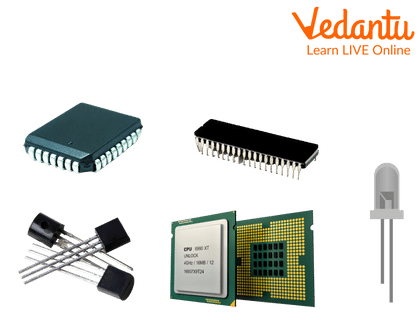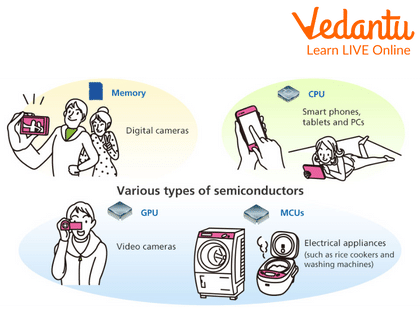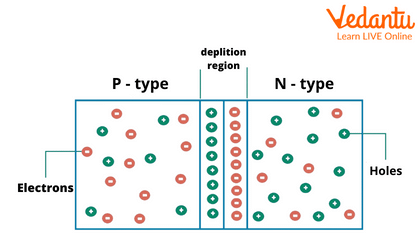




Introduction
A semiconductor is a material that is commonly used in the digital world. It serves as the foundation for the majority of electronic devices. It is used to make small devices such as diodes, transistors, and integrated chips (IC). These devices are found in computers, games, radios, mobile phones, robots, automatic factories, and various other applications. Semiconductors primarily drive today's technology. In this article, we will have an insight into the semiconductors and their uses, along with a few examples and solved questions. Let's start learning!!
What are Semiconductors?
Semiconductors are used for the materials whose conductivity lies in between a conductor and an insulator. Semi means half, and conductor refers to a material that allows current to flow.
An insulator prevents current flow and a conductor allows the flow of current.
Ultimately, A semiconductor is a material that contains both conductor and insulator properties. Electric current can easily pass through the copper conductor.
Further, rubber or wood is an insulator and will not allow an electric current to pass through. However, semiconductor materials such as silicon and germanium can be fabricated so that, under certain conditions, they can act as both a conductor and an insulator.

Semiconductor
What are Semiconductors Used For?
Semiconductors produce various electronic devices and components such as diodes, transistors, and integrated circuits. Because of their compactness, dependability, power efficiency, and low cost, such devices have widespread application.

Semiconductor in Everyday Life
Types of Semiconductors
Semiconductors are classified into two types: intrinsic and extrinsic. An intrinsic semiconductor is a semiconductor in its normal state. Intrinsic refers to the absence of any external material or impurity. On the other hand, an extrinsic semiconductor contains additional materials to increase its electrical strength.
Impurity is an external material, and the process of adding impurities is known as doping. During the doping process, two types of semiconductors are produced; one is known as N-type material, and the other as P-type material.

Types of Semiconductor
Semiconductors of the N-type:
An n-type semiconductor is an intrinsic semiconductor that has been doped with impurities such as phosphorus (P), arsenic (As), or antimony (Sb). For example, group IV silicon has four valence electrons, whereas Group V phosphorus has five.
The Semiconductor of the P-type:
P-type semiconductors are trivalent atom-doped like boron, indium, or gallium. Four silicon atoms surround the impurity atom. However, it can only fill three covalent bonds because it only has three valence electrons.
Semiconductors Today:
Semiconductors are widely used nowadays. Semiconductors are present in basically every electronic device. Without semiconductors, desktop computers, the Internet, tablet devices, and smartphones would not be possible.
Semiconductors can be made into exact switches with a small amount of voltage. The voltage not required by the semiconductor can be routed to other electrical components in the device.
Semiconductors can also be made very small, many fitting into a small circuit.
Electrical devices can now be made thin and lightweight without sacrificing processing power because they can be made so small. Intel Corporation, Samsung Electronics, TSMC, Qualcomm, and Micron Technology are among the leading semiconductor companies.
Solved Questions
1. An increase in temperature at room temperature increases the conductivity of_______.
(a) a semiconductor
(b) a conductor
(c) a superconductor
(d) an insulator
Answer: (a) a semiconductor
2. In__________, the energy band gap is greatest.
(a) copper
(b) an insulator
(c) germanium
(d) a superconductor
Answer: (b) an insulator
3. At room temperature, a substance's valence band and conduction band overlap. The substance could be______
(a) a p-type semiconductor
(b) a conductor
(c) an insulator
(d) an n-type semiconductor
Answer: (b) a conductor
Summary:
Classification of crystalline solids with conductivity intermediate between a conductor and an insulator. Semiconductors are used to make electronic devices like diodes, transistors, and integrated circuits. Extrinsic semiconductors contain impurities that increase conductivity significantly. These materials can be chemically treated to allow the transmission and control of an electric current.
FAQs on Uses of Semiconductors
1. What are the fundamental uses of semiconductors?
Semiconductors are essential materials used to create electronic components like diodes, transistors, and integrated circuits (ICs). Their primary use is to precisely control the flow of electric current, which makes them the foundation for nearly all modern electronic devices, from smartphones and computers to cars and home appliances.
2. What are some common examples of semiconductor use in daily life?
You can find semiconductors in almost every electronic device you use. Common examples include:
- Smartphones and Computers: The processors and memory chips are made of semiconductors.
- LED Lighting: Light Emitting Diodes (LEDs) are a type of semiconductor device.
- Solar Panels: Photovoltaic cells that convert sunlight into electricity are made from semiconductor materials.
- Home Appliances: Modern refrigerators, washing machines, and microwaves use semiconductor-based control circuits.
- Cars: Engine control units, infotainment systems, and safety sensors all rely on semiconductors.
3. Why are semiconductors so crucial for modern electronics?
Semiconductors are crucial because their electrical conductivity can be precisely controlled. Unlike a conductor which is always 'on' or an insulator which is always 'off', a semiconductor can be made to act as a switch. By applying a small voltage, we can turn the flow of current on or off. This ability to switch and amplify electronic signals, combined with their compact size, power efficiency, and reliability, makes them indispensable for building complex circuits.
4. What is the main difference between intrinsic and extrinsic semiconductors?
The main difference lies in their purity and conductivity. An intrinsic semiconductor is a semiconductor in its purest form, such as pure silicon or germanium, and it has very low conductivity. An extrinsic semiconductor is an intrinsic semiconductor that has been intentionally modified by adding a small, controlled amount of impurity, a process called doping, to significantly increase its conductivity and define its electrical properties.
5. How does doping create n-type and p-type semiconductors?
Doping introduces specific impurities to alter a semiconductor's behaviour, creating two types:
- N-type (Negative-type): This is formed by adding a pentavalent impurity (with 5 valence electrons), like phosphorus, to pure silicon. Four electrons form bonds with silicon atoms, leaving the fifth as a free electron, which becomes the majority charge carrier.
- P-type (Positive-type): This is formed by adding a trivalent impurity (with 3 valence electrons), like boron, to pure silicon. This creates a vacancy or a "hole" where an electron should be, which acts as a positive charge carrier.
6. What materials are most commonly used to make semiconductors and why?
The most common material used is silicon (Si). It is preferred due to its natural abundance, stable crystal structure, and excellent performance across a wide range of temperatures. Other important semiconductor materials include germanium (Ge) and compound semiconductors like gallium arsenide (GaAs), which are used for specialised applications such as high-frequency devices and lasers.
7. Can a semiconductor act as both a conductor and an insulator?
Yes, this is the key property of a semiconductor. Under certain conditions, such as very low temperatures, a pure semiconductor behaves like an insulator with very high resistance. However, when energy (like heat or voltage) is applied or when it is doped with impurities, its resistance drops, and it behaves like a conductor. This ability to switch between states is fundamental to its use in electronics.
8. What are some important applications of semiconductors in the medical field?
Semiconductors are vital for modern medical technology. They are used in diagnostic imaging equipment like MRI and CT scanners, digital thermometers, blood glucose monitors, and pacemakers. They also form the basis of highly sensitive biosensors used for detecting diseases and monitoring patient health in real-time.









